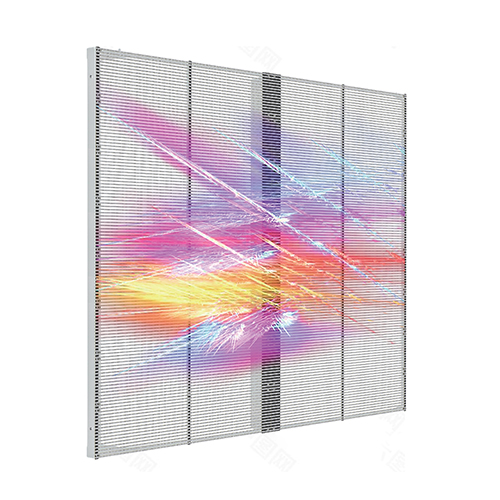NEWS
New Products
Classification of transparent LED screens
2024-12-16As an innovative achievement of modern display technology, transparent LED screens are favored in shopping malls, exhibition halls, window displays and other applications for their transparency, lightness and high definition. Due to the diversity of application scenarios and technical parameters, transparent LED screens can be classified according to transmittance, pixel spacing, brightness level, protection level and installation method. The following are common classification standards for transparent LED screens:
1. Classification based on transmittance
The transmittance of transparent LED screens directly affects the transparency and natural lighting of the screen, which is especially important in glass curtain wall applications. The higher the transmittance, the higher the transparency of the screen, and the less it affects the line of sight and lighting. According to the different transmittance, transparent LED screens are usually divided into the following grades:
High transmittance screen (80%-90% or more): mostly used in shopping mall windows and exhibition halls, high transparency is required to maintain a wide field of view.
Medium transmittance screen (60%-80%): suitable for most commercial scenarios, while retaining good display effects, it can also maintain a certain degree of transmittance.
Low transmittance screen (below 60%): has a stronger display effect, but lower transparency, suitable for applications with low transparency requirements, such as stage backgrounds or partial advertising displays.
2. Classification based on pixel pitch
Pixel pitch (P value) determines the resolution and display clarity of the screen. The smaller the pixel pitch, the more delicate the image, suitable for close viewing; while the screen with a large pitch is suitable for long-distance viewing. Common pixel pitch levels are:
Small pitch transparent screen (P1.5-P2.5): suitable for close-range audiences, such as exhibitions and product launches, can present delicate images.
Medium pitch transparent screen (P3-P5): suitable for medium-distance viewing scenes, such as shopping mall windows, glass curtain walls, etc., can display clear images in a large area.
Large pitch transparent screen (P5 and above): suitable for large outdoor advertisements and high-rise building glass curtain walls for long-distance viewing, with good viewing effect from a distance.
3. Classification based on brightness level
Brightness directly affects the display effect of transparent LED screens, especially in outdoor and high-light environments. The higher the brightness, the clearer the picture. The brightness levels of transparent LED screens are usually divided into:
High-brightness screen (above 5000 nits): suitable for outdoor high-brightness environments or direct sunlight areas, such as shopping mall exterior wall advertisements, to ensure that the screen is still clearly visible under strong light.
Medium-brightness screen (3000-5000 nits): suitable for semi-indoor or shaded environments, such as the inside of a glass curtain wall, with moderate brightness and natural visual effects.
Low-brightness screen (below 3000 nits): suitable for pure indoor use, such as exhibition halls, window displays, etc., with moderate brightness to protect the visual comfort of the audience.
4. Classification by protection level
The protection level determines the durability of the transparent LED screen in different environments. According to the protection performance such as waterproof, dustproof, and anti-collision, the transparent LED screen can be divided into the following levels:
High protection level (IP65 and above): suitable for outdoor environments, with good waterproof, dustproof, and anti-collision functions, and adaptable to complex climatic conditions.
Medium protection level (IP54-IP65): suitable for semi-outdoor scenes, such as transparent screen applications near windows, which can effectively protect against dust and slight moisture.
Low protection level (below IP54): suitable for completely indoor transparent screens, stable environments, and scenes without special protection, such as shopping mall windows.
5. Classification by installation method
The installation methods of transparent LED screens are flexible and diverse. According to the needs of different places, they can be divided into:
Wall-mounted transparent screens: suitable for glass curtain walls of shopping malls and exhibition halls, which can be directly mounted on the wall, saving space and beautiful.
Hanging transparent screens: commonly used for window displays, hanging the screen in front of the window or display stand for product promotion.
Spliced transparent screens: suitable for large advertising walls or glass curtain walls of high-rise buildings, and large-area display effects can be achieved through splicing.
The above is the "classification of transparent LED screens". Transparent LED screens are divided into multiple levels such as transmittance, pixel spacing, brightness level, protection level and installation method to meet the needs of display effects and transparency in different scenarios. The combination of high light transmittance and high definition makes transparent LED screens an ideal choice for modern commercial displays and architectural decoration.






